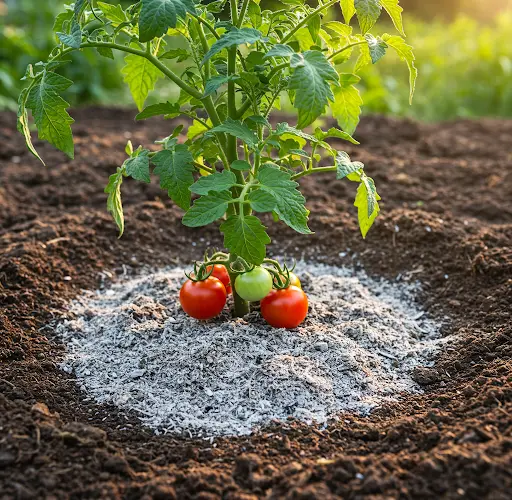The Power of Wood Ash and Horsetail in Organic Tomato Cultivation
Wood ash, a seemingly simple byproduct of burning wood, holds tremendous value in the garden, especially for those seeking natural and organic plant nutrition. Instead of discarding it into landfills, wood ash can be used as an effective, eco-friendly fertilizer to boost plant growth—particularly for tomatoes. Rich in essential nutrients, it can improve soil structure, enhance plant health, and act as a natural pest repellent.
Why Wood Ash Is a Valuable Garden Supplement
Wood ash contains a wealth of nutrients that are crucial for plant development. Among the most prominent are potassium, phosphorus, calcium, and magnesium. These elements play a significant role in plant health and fruit production, especially in crops such as tomatoes, which are heavy feeders.
-
Potassium is perhaps the most important nutrient supplied by wood ash. It enhances fruiting, improves tomato size and flavor, and supports the plant’s overall resilience. Low potassium levels often lead to small or spotty fruit, reduced yield, and general plant weakness.
-
Calcium is vital for strong cell walls and is essential in preventing blossom end rot, a common issue in tomato plants. Symptoms of calcium deficiency include black or brown patches at the blossom end of fruits.
-
Magnesium supports chlorophyll production, allowing plants to maintain green, vibrant leaves. When soil lacks magnesium, leaves may turn yellow, curl, or appear scorched—indicators of a stressed and nutrient-deficient plant.
-
Phosphorus encourages robust root development and supports flower and fruit formation, crucial in the reproductive phase of plant growth.
Pest Repellent Properties
Aside from its nutritional value, wood ash also acts as a natural pest deterrent. Its salt content helps repel common garden nuisances like slugs, snails, and aphids. To use it effectively, sprinkle dry wood ash around the base of plants to form a protective barrier. However, this effectiveness is significantly reduced once ash becomes wet, as moisture dissolves its salts and nutrients. For this reason, only apply ash when the soil is dry and weather conditions are favorable.
It’s important to avoid contact between ash and the plant’s stems or leaves, as the concentrated salts can cause damage. Always apply directly to the soil surface, surrounding but not touching the plant.
Enhancing Wood Ash with Horsetail
To boost the benefits of wood ash, pair it with horsetail—a plant often regarded as a weed but packed with vital minerals. Horsetail contains high levels of silicon, potassium, calcium, iron, magnesium, and manganese. When used properly, it strengthens plants and boosts their resistance to environmental stresses such as drought, diseases, and pest invasions.
Silicon, in particular, is a beneficial but often overlooked nutrient. It fortifies plant cell walls, improving overall vigor and enhancing resistance to fungal infections. The other minerals in horsetail complement the nutrients found in wood ash, creating a balanced and powerful natural fertilizer blend.
You can make a horsetail infusion by boiling chopped horsetail stems in water, allowing the mixture to steep, and then straining it for use as a foliar spray or soil drench. This infusion, when applied in conjunction with wood ash, greatly improves plant health and resilience.
Important Considerations When Using Wood Ash
Using wood ash in the garden is simple, but it must be done correctly to avoid damaging plants:
-
Cool Completely Before Use: Never use hot ash. High temperatures can damage or kill plant roots, especially delicate crops like tomatoes. Always let wood ash cool down fully before handling or spreading it.
-
Keep Ash Dry: Wood ash is water-soluble. Once wet, it loses many of its beneficial properties and may leach nutrients away from the root zone. Store it in a dry place and apply only to dry soil.
-
Mind the Soil pH: Wood ash raises soil pH, making it more alkaline. This is beneficial for tomatoes and other crops that thrive in neutral to slightly alkaline soil. However, it should be avoided around plants that prefer acidic conditions. Do not apply wood ash near potatoes, parsley, blueberries, or rhododendrons, as they perform best in acidic soil environments.
-
Apply Sparingly: A little goes a long way. Over-application of ash can alter soil chemistry and negatively affect plant growth. Use a thin layer—just enough to surround the base of each plant.
Final Thoughts
Utilizing wood ash and horsetail in your garden is a cost-effective and sustainable way to nourish plants naturally. Tomatoes, in particular, benefit from the rich potassium and calcium content of wood ash, while horsetail brings a mineral-rich boost that strengthens plant immunity and resilience.
With proper application, these natural fertilizers can significantly improve plant health, increase yields, and reduce dependency on synthetic chemicals. Embracing these organic methods is a simple step toward more sustainable and productive gardening.



